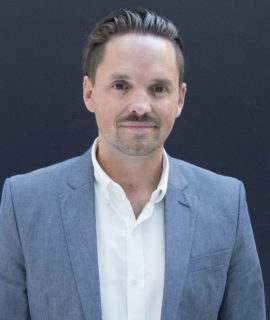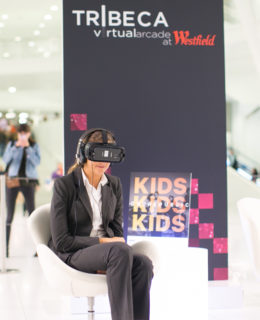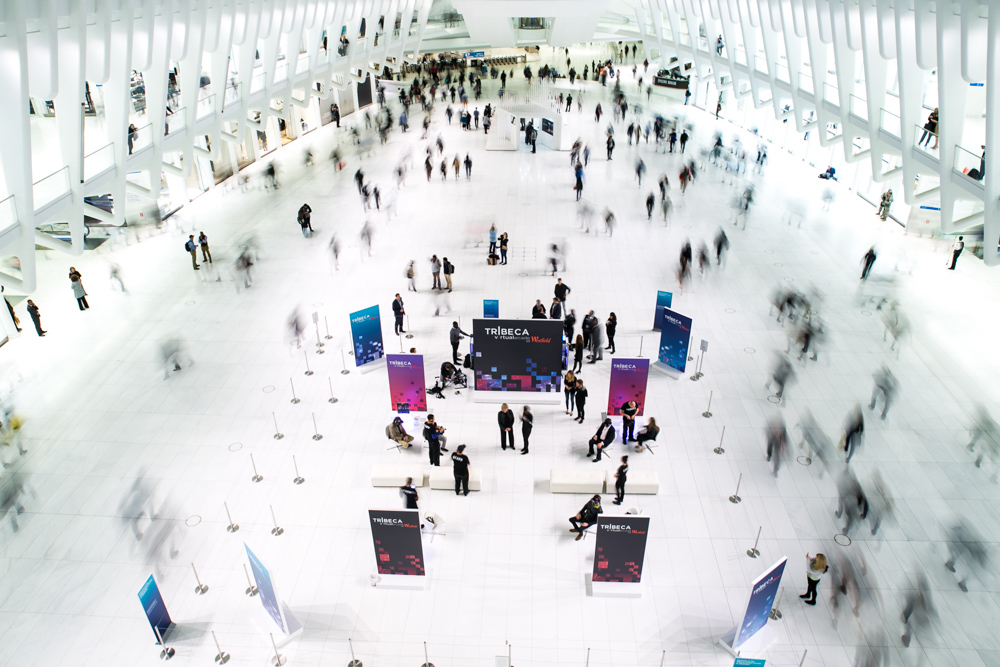Earlier this year, the Tribeca Enterprises helped grow the field of virtual reality entertainment by introducing a VR Arcade at the Tribeca Film Festival, showcasing a multitude of experiences, in addition to premiering the acclaimed VR animated short, Invasion! The humorous film, featuring a bunny that repels an alien attack, became an instant hit and the creators at Baobab Studios are already working on a sequel while the VR short is being adapted to a 2D feature film.
Now Tribeca is taking VR entertainment to the next level by going beyond the confines of the festival and opening the free-to-use Tribeca Virtual Reality Arcade last weekend at the Westfield World Trade Center in lower Manhattan. The arcade, which uses Samsung Gear VR viewers, will be open for two more weekends from 12-8pm on November 11-13 and November 18-20, giving shoppers and tourists a chance to experience virtual reality, perhaps for the first time.
Featured experiences include Invasion!, which provides even more people a chance to experience life from an animated bunny’s point-of-view. It is accompanied by the first episode of Invisible, a supernatural serial drama created by famed director Doug Liman (The Bourne Identity, Edge of Tomorrow), 30 Ninjas, Jaunt VR, Samsung VR, and Condé Nast Entertainment. Cirque Du Soleil’s VR experience, KÀ: The Battle Within is also being showcased, taking viewers on an acrobatic dance journey. Lastly, there’s OneRepublic’s VR music video for “Kids.”
“Kids,” OneRepublic’s newest hit single from the album Oh My My, has both a 360-degree video and a traditional 2D music video. However, what makes the VR version particularly impressive, in addition to the technology, is that it’s shot in one take using over 100 performers including the band. Director, Hal Kirkland, spoke with [a]listdaily from the Tribeca Virtual Reality Arcade debut about putting together the VR music video for “Kids” and discusses how he thinks the technology helps the music industry and bands engage with their audiences.

How did you come to work with OneRepublic to create a VR music video?
Originally, Universal Music and Interscope, who work with those artists directly, wanted to get into VR. Also, Nokia Ozo, the camera that we filmed it with, wanted to push their technology. So, a partnership was formed between those companies. They put the brief out there for people to present ideas, and luckily this was that idea that moved forward.
Working with VR technology must be challenging by itself. What inspired you to do a one-take video?
What inspired me was that it hadn’t really been done in this way before. I think that the idea came about after listening to the song and picking a really simple story about a girl and a guy and their relationship developing. I tried to imagine different ways to do this that hadn’t been attempted before and I think that because I was planning for a VR piece and a 2D piece that needed to happen in the same location, I wanted the VR piece to really push the viewer in a way that pushed the medium as well.
How did OneRepublic take to making the video?
OneRepublic were amazing. They were instrumental in this happening because of the complexity of the shoot. The fact that that we were trying to get a one-take, it relied on the precise choreography of over one hundred people. They were so into it and so supportive of the technology in general, and they turned up on time and got all the choreography immediately. Without their help, showmanship and professionalism, the entire piece wouldn’t have been possible.
Do you think VR will usher in a new wave of popularity for music videos?
Yeah, I think VR technology will definitely be used more and more in a music video context. Due to the complexity and expense of creating in this medium in a high-quality way, I think there will be a necessity for a certain level of dedication from the partners funding those kinds of creations. Music video-land tends to be low budget, “let’s do it in two weeks’ time,” [production]. A song will release and a label will say, “we need to get this song out immediately, where’s our film?”
In this instance, you need time to plan it out properly. You need the technical expertise and the planning from that side of things. For the quality to be created, you need a certain amount of budget as well. Every VR project is ultimately a VFX job, because you’re stitching together everything that you’ve filmed. It’s such a huge process that it can’t be done instantly.
What do you think will be the challenge in making VR content moving forward?
A challenge that a lot of people are facing right now is integrating narrative. I think it’s more than possible and it will be continually refined. The challenge is that VR, because it’s so new, is so immersive that it can also become distracting. It gives you that freedom to look in any direction, and the challenge is in using directorial techniques that allow you to feel that freedom and immersion while being directed toward the action you’re meant to be watching. Going forward in the industry will be about refining those two worlds, and I think that will be helped along by VR spreading even further and people’s perception of it getting more advanced.

How do you balance between focusing on the story and the band itself?
You’ve got to use almost old-school techniques. You’ve got to make what the key characters are doing compelling, and you’ve got to choreograph them with interesting enough action to hold viewing. I feel like you’ve got to plan your direction, almost like you’re choreographing stage action. You’ve also got to think about your world and construct it so you’re blocking what you don’t want people to see, but it doesn’t look as though you are. Or you’re creating a stage where you want the actor to move around and doesn’t seem limited. It’s a matter of planning that choreography ahead of time.
How does an experience like the “Kids” music video help bands like OneRepublic engage with fans?
I think it helps OneRepublic engage with fans by inviting them into a world. Music videos have traditionally been great for us to get a sense of the characters and people inside them and whether or not it’s a persona or the real them. VR actually invites people into their world, temporarily. That’s a really interesting step for a band to do, because you can see the band members in front of you, and they appear to be physically next to you, wherever they are in that scene or story. That gives you a certain level of intimacy or closeness that establishes a stronger connection between the band and the audience.

